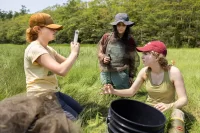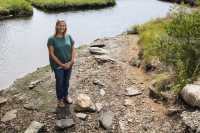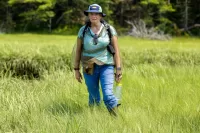
The Environmental Protection Agency (EPA) released on Aug. 8 the first ever regional assessment of the carbon sequestered in vegetated coastal habitats — better known now as blue carbon — from Maine to Long Island, New York. The report was three years in the making and drew on the work of more than two dozen working groups from federal and state agencies and academia.
“It’s groundbreaking and a true joint project,” said Beverly Johnson, Bates Professor of Earth and Climate Sciences, a co-author of the new report. Johnson is also a member of the Maine Climate Council Coastal and Marine Working Group. “So many people pulled together data sets from up and down the coast to establish this overview of where these essential resources are.”
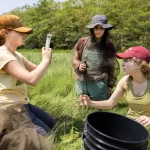
In the Marsh
Read about Beverly Johnson and her student researchers doing their blue carbon field work in the Sprague Marsh at Bates–Morse Mountain Conservation Area.
Core data from Maine in the EPA report was gathered almost entirely by Johnson and her Bates student researchers between 2012 and 2018. “Close to 80 percent of the salt marsh data from Maine comes from student theses.”
Maine and Massachusetts contain by far the most acreage of blue carbon habitat of the northeastern states, according to the report. Massachusetts has over 112,000 acres of sea grasses and salt marshes, about 52 percent of the overall habit assessed regionally. Maine has almost 54,000 acres of salt marshes and sea grasses or 25 percent of the overall habitat.
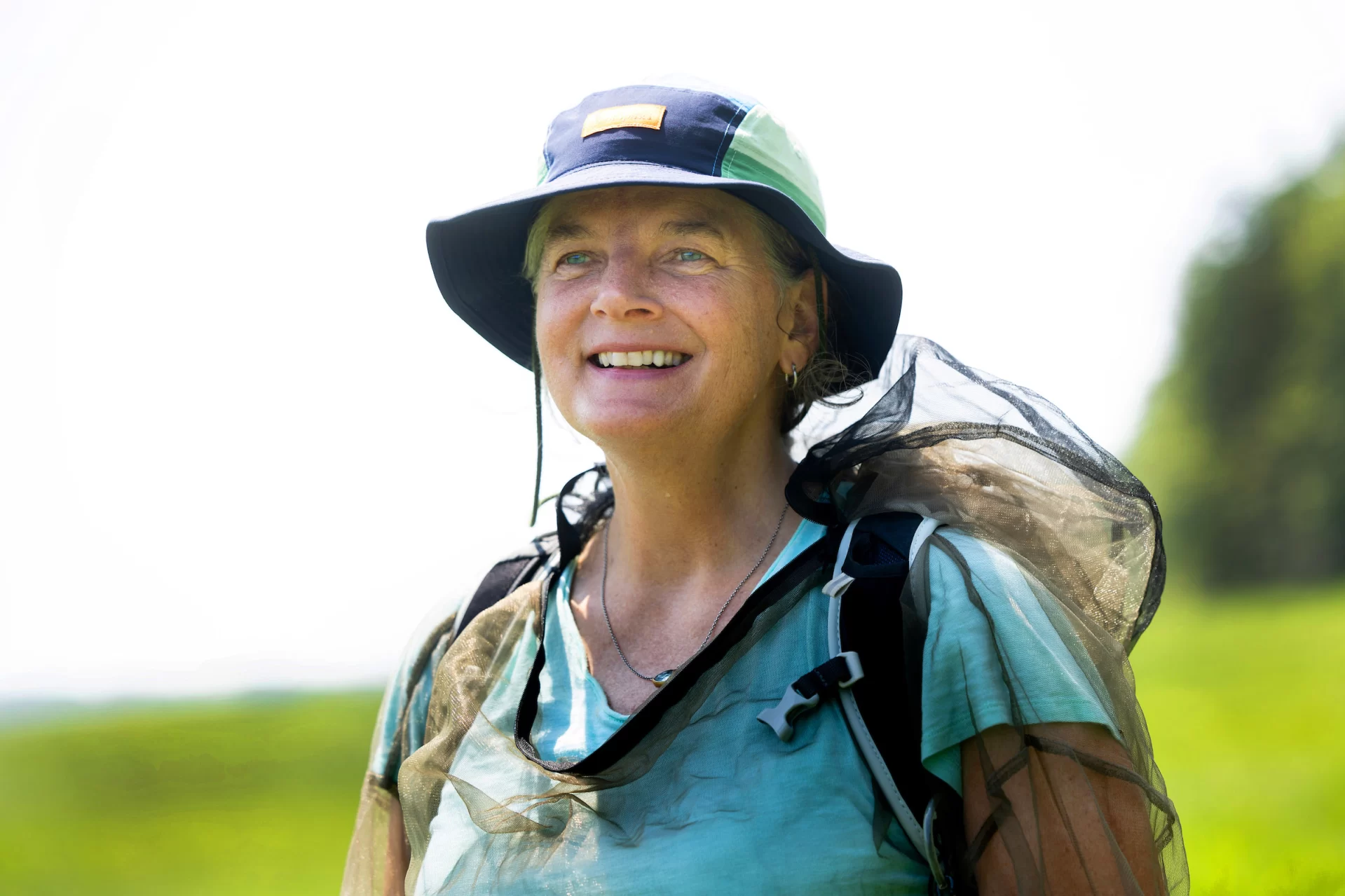
The term blue carbon was coined by global conservation groups in 2009. The Northeast region encompasses coastal vegetative habitat, such salt marshes and sea grasses (mangroves are a key blue carbon reservoir, but don’t grow in the Northeast). Maine has the most eel grass of any of the states surveyed, about 34 percent of the regional total.
To Learn More
For news media interested in an interview with Beverly Johnson, please contact Mary Pols, media relations specialist at Bates College, mpols@bates.edu or 207-786-8248.
While many people are familiar with the idea of trees as carbon reservoirs or sinks (green carbon), blue carbon is only now gaining greater public awareness as a key tool in fighting climate change.
“These are powerful carbon sinks,” Johnson says. “If you compare the same area of forest to salt marshes and other blue carbon systems in terms of how much carbon is going into the ground, blue carbon systems are moving four to 10 times more carbon into the ground than forests. So they are very effective at photosynthesis and then sequestering and storing that carbon for a long period of time.”
According to the EPA, nearly half the seagrass habitat on the East Coast of the United States has been lost in the past century, with little chance of recovery in most cases. Threats to water quality, including runoff from agriculture and urban areas, create unfavorable conditions for seagrass. Preserving and restoring existing seagrass meadows and other coastal wetland habitats will be crucial to achieving carbon dioxide emissions reductions.
She’s working with a team of Bates College students gathering more data this summer, using a state of the art assessment tool manufactured by LI-COR that measures fluctuations in greenhouse gasses. Maine Sea Grant funded the tool for the Bates project.
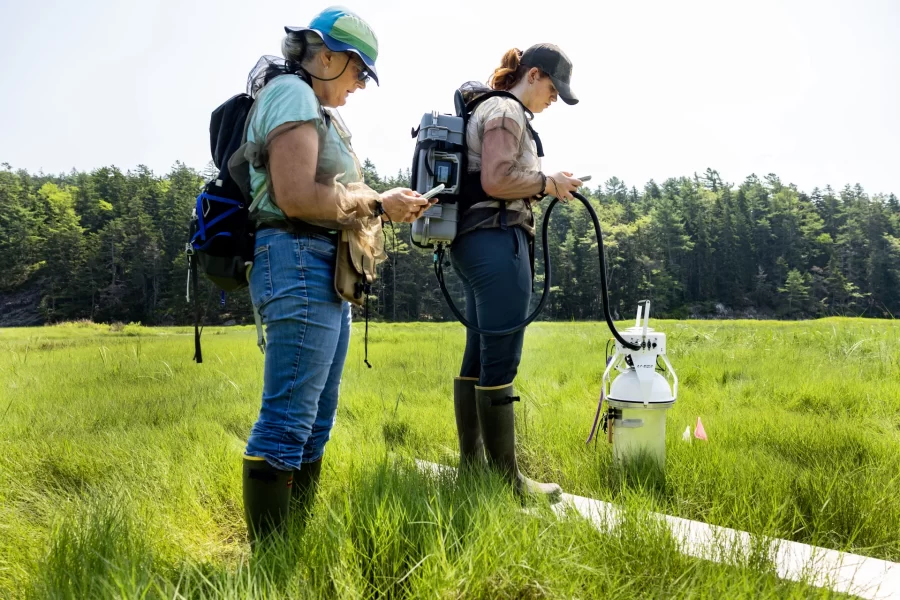
“It used to take us about six hours to get one of these greenhouse gas flux measurements,” Johnson said. “With this new tool, now it takes us about three minutes. We are gathering a ton of really fabulous data from four different marshes, which will be used to estimate the carbon benefits associated with restoration.”
Time is of the essence. Despite the relative abundance of salt marshes and eel grass in Maine, Johnson said this valuable resource is threatened, both by sea level rise — which can drown and destroy the marshes if it happens too rapidly — and other human impacts.
”I think of them as being on the verge of extinction,” Johnson said. “And that the decisions we make now and over the next 10 years are going to determine whether these ecosystems persist.”
Having this baseline from the EPA is key, Johnson said, but the work is not done. “We have expanded our site assessment since the data were compiled for the report and have a much better sense of blue carbon stocks and sequestration in the state of Maine. There’s much more variation in individual salt marshes than is indicated by the EPA report. We are taking a closer look.”
The EPA report uses satellite imagery of coastal ecosystems to assess the carbon reservoirs as a whole. “But we are finding that the amount of carbon stored beneath the surface of a salt marsh is not always consistent with what is predicted by the overlying vegetation. In other words, what you see at the surface is not always reflected underneath,” Johnson said.
This article was prepared by Bates College using Federal funds under award NA22OAR4170121 from the University of Maine System/Maine SeaGrant, U.S. Department of Commerce. The statements, findings, conclusions, and recommendations are those of the author(s) and do not necessarily reflect the views of the University of Maine System/Maine SeaGrant or the U.S. Department of Commerce.
